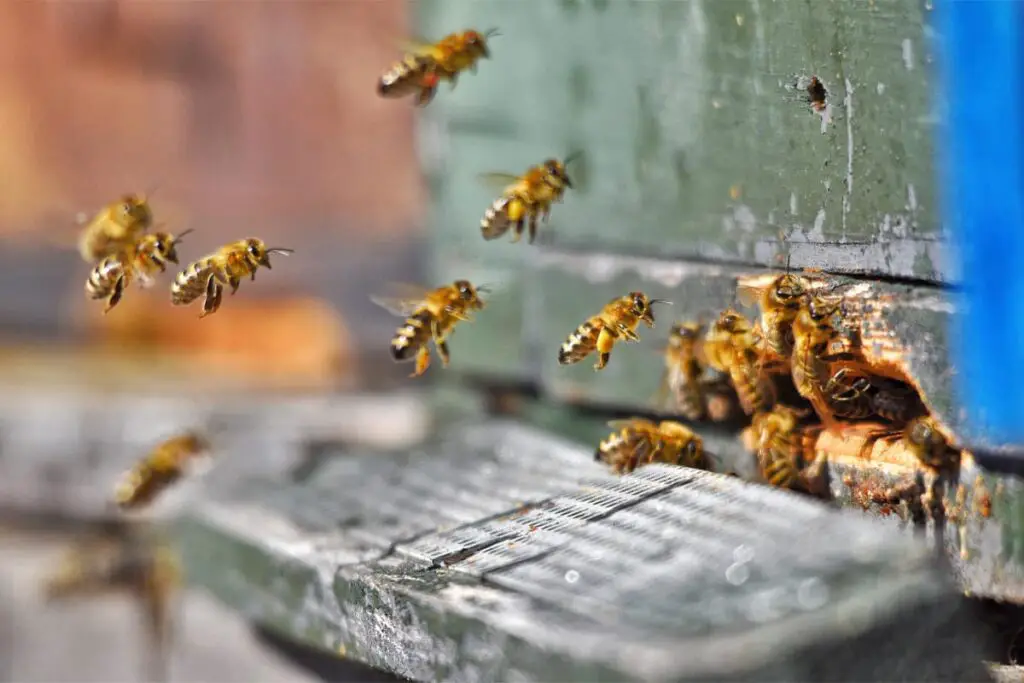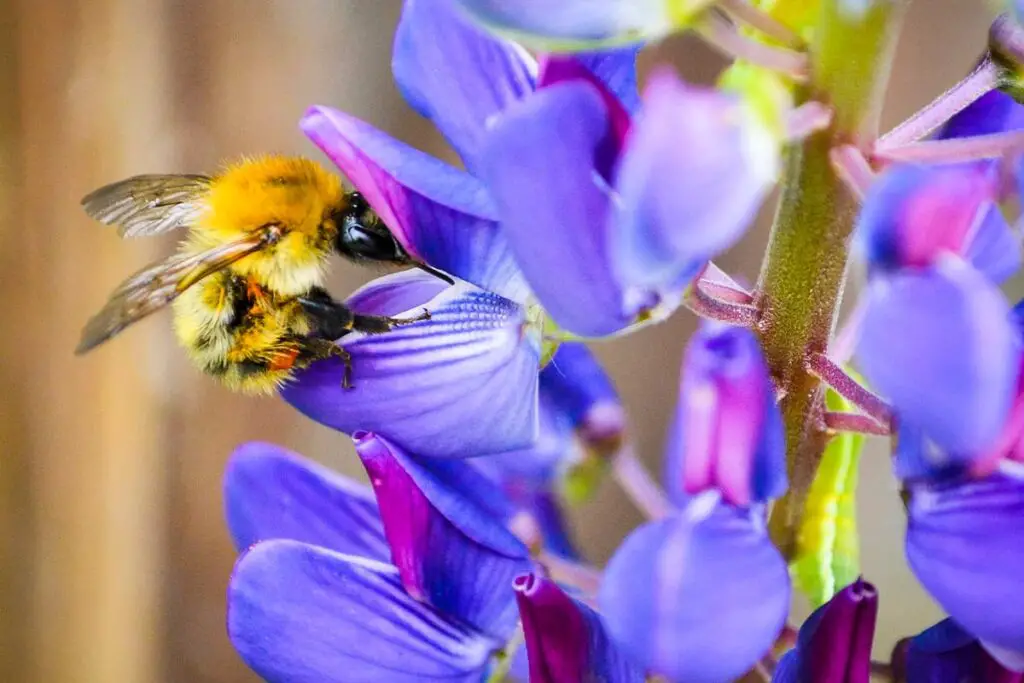
One of life’s greatest joys has to be watching insects like bees and butterflies go from flower to flower in a gigantic colorful garden. Unless of course you’re allergic, in which case watching from a window is just as good. As we watch these busy little miracles go to and fro, buzzing from flower to flower, it begs the question: why do they bother?
Bees move from flower to flower to collect nectar and pollen for themselves and their colony. This affords the individual bee with the energy they need to travel from the hive to multiple plants, while collected nectar and pollen provides the colony with the nutrients to grow and survive the winter.
While it is fun to watch bees work, it’s also fascinating to understand the why and how behind their activity. How do plants attract bees to begin with? Let’s dive a little deeper.
How Do Flowers Help Bees?
For a bee to fly from its nest to a flower, return to their nest, and then fly to a different flower, it needs to consume a lot of energy. After all, their wings will practically not stop beating until they get back home for a rest. Even then they’re still busy taking care of the queen and working on any one of the thousands of tasks needing to be done within the nest.
All of this work means that bees need a lot of sustenance, which flowers provide. Flowers secrete nectar, a sweet energy-packed substance that serves as a form of energy drink for pollinating insects. When they’ve had their fill, they will collect even more of the nectar to bring back to the hive, and as much of the flower’s pollen as they can carry.

When worker bees bring nectar and pollen back to the colony, the pollen is given to the bee larvae to give them the protein they need to grow. Pollen is also the only source of protein the rest of the colony eats, so it’s vital for their survival.
Meanwhile, the nectar that was collected is gathered together and put through a process that will eventually produce honey. This honey gives the colony the minerals, fats, and vitamins they need to survive, particularly through winter.
Why Do Flowers Need Bees?
This interaction isn’t a one sided affair in favor of bees, but a truly mutually beneficial relationship. For flowers to stay healthy and create more copies of themselves, they sometimes need help from animals to spread their pollen far and wide.
Flowering plants and trees don’t necessarily need pollinators like bees, hummingbirds, or butterflies to help them. They can also fall back on wind power if they really have to, but the wind can be unreliable. It’s not going to disperse the pollen to other flowers as accurately or effectively as your garden’s bug population.
Flowers rely on the coordination of pollinating insects and birds to take the pollen, or germ seed, of the male plants, and bring it to the pistils of the flowers of the female plants, so that fruit-carrying seeds become fertilized and begin to develop.
This will create the next generation of flowers, and also allows them to disperse to more locations.
For such a vital part of the survival of blooming plants, trees, wildflowers, and vegetables, it wouldn’t be something the flowers would leave to chance. They have a few tricks up their sleeves to draw pollinators to themselves.
How Are Bees Attracted to Flowers?
As flowers rely on bees (and other pollinating creatures) to reproduce, they have developed creative ways to beat the competition, be the more attractive plant, and get all the attention. As we’ve explored previously, bees see flowers a little differently than we do. The colors we see the flowers as are not the same colors a bee would see.
In the bee’s vision, the most attractive flowers have the most obnoxiously bright colors, kind of how the biggest, brightest, and multi-colored neon signs will attract our attention to certain buildings. This is the flower’s way of being a bee’s ‘landing lights’, and directing it to the pollen.

This is made easier when the flowers have wide areas for the bee to land on, according to Canada’s Agriculture and Food Museum. A perfect example of this in action is the sunflower.
This isn’t the only mechanism plants use to pollinate. Plants that don’t have blooms quite as extravagant as flox (for example) have another tried and tested method: smell. Many flowers, but especially herbs, have wonderful scents that make them high value targets for bees without the need for all that showing off.
Why Do Bees Go From Flower to Flower?
You might be wondering how one plant is able to get the pollen of the same species of plant it needs in order to actually germinate its seeds. It doesn’t make sense for daisy pollen to germinate lavender, does it? Well, actually…

As bees and other pollinators do what they do, the pollen of one plant will inevitably end up in on the pistils of another. You might be surprised to learn that this cross-pollination actually creates a heartier genetic mix, which will help the next generation survive.
Still, bees do have an interesting behavior pattern called “flower constancy.” Flower constancy is where pollinators, including bees, stick to visiting certain plants rather than going willy-nilly across a field and garden, choosing at random.
When a bee drinks nectar and collects pollen from a daisy, for example, then it will continue to look for other daisies, along with a few other choice flowers. In this way, the daisy is more likely to send its pollen to the female pistils that it intends. It’s a curious and fascinating relationship.
What Flowers Attract Bees?
There are numerous plants that attract bees and other pollinators, all of which have at least one of the methods we listed earlier to entice bees. Here are a few examples.
- Aster
- Borage
- Buttercup
- Calendula
- Cilantro
- Crocus
- Geranium
- Heliotropium
- Hollyhock
- Honeysuckle
- Lavender
- Poppy
- Sage
- Snowdrop
- Sunflower
- Sweet Allysum
- Thyme
- Zinnia
You’ll notice that all of these plants use either super bright colors, perfumes, shapes with large ‘landing zones’, and/or an abundance of nectar to make them the first choice for a passing bee.
How can you attract bees to your garden?
If you love to watch these wonderful busy workers, you might be wondering how to attract them into your own yard.
The obvious solution is to plant a pollinator garden. The best pollinator gardens include a variety of plants, and are designed to attract different kinds of bees with different flower constancies. Having a variety of plants that present different colors, an abundance of nectar, and delicious aromas is your best bet.
For vegetable gardens, planting flowers and herbs around them is a good way to make sure your hard-earned food isn’t neglected.
You can also attract bees by providing nesting sites for them. The Pen State College of Agricultural Sciences has noted that 70% of bees living in North America love to make their homes underground. Soils that resemble what you would find at a seasonal lakebed that make great mud and have small pebbles for the bees to use are ideal.
To attract bees that prefer to live above ground, try providing stones with cracks, hollow sticks, or a decorative log of wood. For better viewing opportunity, there are also bee houses commercially available.
If you’re feeling adventurous, you could even have a go at making one yourself.
Resources:
- How does Pollination Work? – YouTube
- Plant Flowers That Attract Bees. – Life Is Just Ducky
- 18 Plants that Attract Bees to your gardens (Save the Bees) – YouTube
- Flower constancy – Wikipedia
- The ABC’s of Bees | Triangle Gardener Magazine
- Why are bees attracted to flowers? – BBC Bitesize
- Why do bees like flowers? | The Children’s Museum of Indianapolis (childrensmuseum.org)
- How To Attract Pollinators To A Vegetable Garden – Cooped Up Life
- How Do Plants Attract Bees? | Bees A Honey of an Idea (techno-science.ca)
- What do Bees do with Pollen? – Carolina Honeybees
- Why Are Bees So Important To Our Ecosystem? – The New Ecologist
Driven by a passion for those tiny creatures that rule our world, we at Bug Domain strive to be your go-to resource for information on insects.



